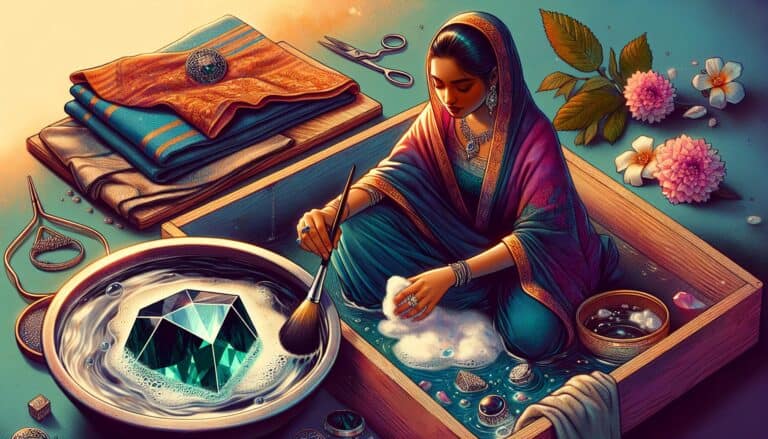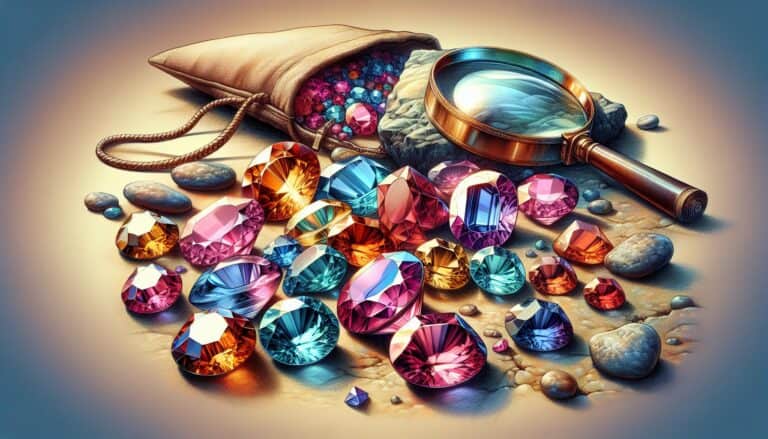Ever wondered if that sparkler on your finger is the real deal?
Identifying a genuine diamond can seem daunting, but with the right know-how, you’ll be distinguishing the gems from the fakes in no time.
Whether you’ve inherited a stone or are shopping for that perfect piece, knowing what to look for is key.
The article provides a comprehensive guide to identifying real diamonds, including visual inspection, various tests, understanding their formation and origins, safety tips for diamond hunting, and proper care for found diamonds.
How to Identify Diamond Through Testing
Visual Inspection
To begin with, Visual Inspection is a simple yet effective step. Examine the diamond for any imperfections or inclusions. A real diamond often has minor imperfections, while a fake might appear flawless. Pay attention to the reflections: real diamonds show shades of gray inside them, not colorful rainbow reflections. Additionally, the edges of a genuine diamond are usually sharp, compared to imitations that often have rounded edges.
The Streak Test
Performing The Streak Test is straightforward – drag the diamond across a piece of unglazed porcelain tile and observe the streak it leaves. A genuine diamond won’t leave a visible streak because it’s harder than the tile, while a fake is more likely to leave a colored streak.
Magnet Test
While diamonds are not magnetic, conducting a Magnet Test can sometimes help. Run a strong magnet over the stone. If it’s attracted to the magnet, it’s not a real diamond. Remember, this isn’t a definitive test, as not all fake diamonds are magnetic either.
Hardness Test
The hardness test involves using a scratch test kit or comparing the stone to substances with known hardness. A real diamond can scratch materials with a lower ranking on the Mohs scale of hardness. Be cautious, as this can damage the stone.
Birefringence Test
Check for birefringence by looking through the diamond with a magnifying glass. Birefringence occurs when a ray of light splits and creates a double image. If you notice double faceting or a ‘fuzzy’ appearance to the facets, the diamond exhibits birefringence, a characteristic not present in synthetic counterparts.
Checking the Diaphaneity
Examining the diaphaneity, or transparency, of a diamond involves observing how light passes through it. A pure and high-quality diamond will have high transparency, unlike many diamond simulants which can appear more translucent or opaque.
Single or Double Refraction
Most diamonds exhibit single refraction, meaning they bend light in one direction. When examining the stone, if you notice a single clear reflection, it likely means it’s a real diamond. Fake diamonds made from materials like cubic zirconia often show double refraction.
Refractive Index Test
By using specialized equipment such as a refractometer, you can perform a Refractive Index Test to measure how much a diamond bends light. Diamonds have a specific refractive index ranging from 2.417 to 2.419, which is higher than most simulants and can reliably indicate authenticity.
Finding the Specific Gravity
A diamond’s specific gravity is unique to its composition. By using a water displacement test or a hydrostatic balance, it is possible to determine whether the specific gravity matches that of a real diamond, which is approximately 3.52.
Identifying Diamonds in the Field
When you’re trying to identify diamonds in the field, familiarize yourself with typical diamond-bearing rocks such as kimberlite and lamproite. Also, note that diamonds have a metallic luster and are found in volcanic pipes.
Recognizing Potential Diamond Rocks
Recognizing Potential diamond Rocks requires knowledge of geology. Look for indicator minerals such as garnets, chromites, and olivine in conglomerate formations. These minerals often accompany diamond deposits and can signal the presence of diamonds within certain rocks.
Physical Characteristics of Diamond

When you’re assessing diamonds, it’s crucial to understand the physical characteristics that set them apart from other gemstones. Diamonds boast a distinctive crystal structure, which is isometric or cubic. This means that the crystals develop into well-known shapes such as octahedrons and tetrahedrons, typical indicators of a diamond’s authenticity.
- Crystal Shape: Look for common diamond shapes like octahedrons and dodecahedrons.
- Surface Texture: Diamonds often have a greasy luster that can help distinguish them from imitators.
In terms of luster, diamonds have a unique adamantine luster, a term that refers to the diamond-like shine they exhibit. This is a result of their high refractive index, which not only gives them their brilliance but also aids in their identification.
Hardness is another key trait when identifying diamonds. With a score of 10 on the Mohs scale of mineral hardness, diamonds are renowned for their ability to scratch any other material. Always use a tester with caution to avoid harming potentially valuable stones.
Lastly, diamonds have a specific gravity of about 3.51 to 3.53. While precise measurements require professional tools, knowing the weight range can be helpful when compared to other materials of a similar size.
Note these physical aspects are equally as crucial as the tests you’ve just learned. Combining your knowledge of both will greatly increase your chances of accurately identifying real diamonds.
How Are Diamond Formed?
Diamonds are born from intense heat and pressure deep within the Earth’s mantle. This process begins over 100 miles below the Earth’s surface and can take over a billion years to complete. The carbon atoms bond in a unique way that results in the hardest material on the planet.
The Journey from the Depths
The ascent of diamonds to the Earth’s surface is a tale of volcanic eruptions. Kimberlites, which are types of volcanic pipes, act as elevators bringing diamonds closer to the surface. These explosive eruptions shoot the minerals through the crust, cooling rapidly to form kimberlite rocks where diamonds are often found.
- Extreme pressure: It’s the equivalent of being squeezed under the weight of Mt. Everest.
- Intense heat: Temperatures soar above 2000°F, facilitating the formation of the gems.
- Volcanic activity: Only certain types of volcanic eruptions can transport diamonds without destroying them.
As you continue your quest to identify real diamonds, understanding their creation adds depth to your knowledge. Knowing the conditions in which they form can also help you identify the most likely places to find them and can provide insight into the authenticity of a potential diamond based on its origins and characteristics.
Preparation for Diamond Hunting
Gathering the Right Tools
Before you embark on your diamond hunting adventure, it’s critical to arm yourself with the proper tools. These aren’t just any tools; they’re your ticket to uncovering these hidden gems. High-quality geology tools are a must-have. Think of them as your treasure hunting sidekicks. You’ll want a geologist’s hammer, a shovel, and a set of sieves – essential for sifting through soil and gravel. Don’t overlook portable light sources like a headlamp or flashlight, as these can help you identify possible diamonds by revealing their unique shine and glitter. Moreover, always have a pair of tweezers on hand to pick up potential finds without damaging them.
A sturdy pouch or container to store your finds is also non-negotiable. It ensures that any diamonds you uncover are kept safe and sound until they can be examined more closely. For those keen on the state of their finds, a jeweler’s loupe can prove invaluable. This allows for the immediate examination of the stones’ characteristics in the field, saving you time and possibly uncovering a diamond in the rough on the spot.
Safety Considerations
When you’re out hunting for diamonds, you’re not just searching for treasure, you’re venturing into the great outdoors, and that requires a respect for safety. Ensure you’re dressed for the part; durable clothing is a must to protect against the elements and rough terrain. Appropriate footwear that can handle mud, water, and uneven ground will keep you agile and prevent injuries.
It’s also wise to pack a first aid kit for any unexpected mishaps. Nature can be as unpredictable as it is thrilling, so be ready to tend to cuts or bruises that may occur while you’re scouring the earth. Additionally, it’s essential to keep hydrated and bring enough food to maintain your energy levels throughout your search.
Inform someone about where you’re going and how long you expect to be out. This is a simple yet crucial step that should not be overlooked. Should anything go awry, you’ll be glad someone knows your whereabouts.
Always check the weather forecast before leaving. Inclement weather not only hampers your diamond hunting efforts but can also pose serious risks.
Handling and Care of Found Diamonds

When you’ve successfully identified a diamond, it’s crucial to handle and care for it properly. This ensures that the gem maintains its condition and value. Proper care can prevent damage and preserve the stone’s natural beauty.
Cleaning Diamonds
Thorough and careful cleaning is essential for maintaining a diamond’s sparkle. Begin by using a soft brush and mild soap in a solution of warm water to gently scrub your diamond. Avoid harsh chemicals or abrasive solutions that can scratch the stone or damage any setting it may be in. Once cleaned, rinse the diamond with clean water and dry it with a lint-free cloth.
If the diamond has a significant amount of soil or debris, consider soaking it in the soapy solution for a few minutes before brushing. Keep in mind that ultrasonic cleaners should only be used if you’re sure that the diamond is not fractured or filled, as the high-frequency vibrations can sometimes exacerbate these issues.
Storing Diamonds
Proper storage of diamonds is just as important as cleaning. If you place your diamond indiscriminately, you risk scratches or chipping. Store each diamond separately in a fabric-lined jewel case or in a box with compartments or dividers. For additional security, wrap each stone in a soft cloth.
It’s also wise to ensure that any storage area you choose is dry and secure. Dramatic changes in temperature or moisture can affect a diamond over time, even though they’re one of the hardest natural substances on Earth. For those with more than a few stones, consider investing in a safety deposit box or a home safe for greater peace of mind.
Remember, a well-maintained diamond not only shines brighter but also holds its worth better in the long run. Your care in cleaning and storing these stones contributes significantly to their longevity and value.
Conclusion: Confirming a Real Diamond
You’ve now mastered the art of diamond identification with a range of tests and observations that are key to distinguishing the real gems from the fakes.
Remember, it’s all about the details—paying close attention to physical properties like hardness, luster, and specific gravity will guide you to make accurate assessments. Don’t forget the importance of proper handling and care for your diamonds to ensure they retain their sparkle and value. Armed with this knowledge, you’re well-equipped to confirm the authenticity of your find and keep it in pristine condition for years to come.
Keep these tips in mind, and you’ll shine just as brightly as your newfound treasures.


![Oregon Rockhounding Sites in [year]: Gems & Gold Spots](https://observationhobbies.com/wp-content/uploads/2024/01/zvbNyGO3hFnie_QEOh9l0-768x439.jpg)
![Maryland Rockhounding Sites in [year]: Spots & Finds Guide](https://observationhobbies.com/wp-content/uploads/2024/01/c8W6Ie1LDTCHRwwEVRUYX-768x439.jpg)


![ND Rockhounding Sites in [year]: Treasures & Finds](https://observationhobbies.com/wp-content/uploads/2024/01/NXhSmnQX-d6GEwx7lYbig-768x439.jpg)
![Kansas Rockhounding Sites in [year]: Best Spots & Treasures](https://observationhobbies.com/wp-content/uploads/2024/01/MEpyAlU09VN0IV9zhK62K-768x439.jpg)